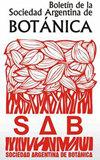Valve morphology of Didymosphenia geminata (Bacillariophyceae) from Santa Cruz and Tierra del Fuego provinces, Patagonia, Argentina.
IF 0.7
4区 生物学
Q4 PLANT SCIENCES
Boletin De La Sociedad Argentina De Botanica
Pub Date : 2020-11-10
DOI:10.31055/1851.2372.v55.n4.29634
引用次数: 0
Abstract
Background and aims: In 2013, blooms similar to those produced by Didymosphenia geminata (Lyngbye) M. Schmidt around the world, were detected in the Grande River basin, Tierra del Fuego province, and in 2014 in de las Vueltas River in Santa Cruz province. The aim of this paper is to analyze the valve morphology and morphometry of these materials to establish if they correspond to D. geminata or to other species of the genus that is producing the massive growth in southern Patagonia. M&M: Samples were collected at Grande River in 2013 and 2015 and, in de las Vueltas River in 2015 and 2016. Samples were analyzed with light and electron microscopy. For morphometric analyses 100 specimens from each sample were measured and statistical analyses were carried out using the R statistical package. Results: The studied populations have the same fine morphology described for other populations collected in Patagonia. Nevertheless, in some sampling sites from Santa Cruz province, we found a morphotype with a markedly smaller size, subcapitated poles, little marked constrictions of the poles, a broad central area (relative to cell size) and 1 to 3 stigmata, that was never reported in South America. Conclusions: The studied populations correspond to D. geminata ssp. geminata Metzeltin & Lange-Bertalot. From a morphological point of view the smaller morphotype present in Santa Cruz belongs to the same subspecies but can be easily misidentified during the routine monitoring programs carried out with light microscope due its size and valve outline.阿根廷巴塔哥尼亚圣克鲁斯省和火地岛省双叶硅藻门的瓣形态。
背景和目的:2013年,在火地岛省的格兰德河流域发现了类似Didymosphenia geminata (Lyngbye) M. Schmidt在世界各地生产的花,2014年在圣克鲁斯省的de las Vueltas河发现了类似的花。本文的目的是分析这些材料的瓣形态和形态计量学,以确定它们是否对应于D. geminata或在巴塔哥尼亚南部大量生长的该属的其他物种。M&M: 2013年和2015年在Grande River采集样本,2015年和2016年在de las Vueltas River采集样本。用光镜和电镜对样品进行分析。形态计量学分析采用R统计软件包进行统计分析。结果:所研究的种群具有与在巴塔哥尼亚收集的其他种群相同的精细形态。然而,在圣克鲁斯省的一些采样点,我们发现了一种形态型,其尺寸明显较小,两极近头,两极几乎没有明显的收缩,中心区域宽(相对于细胞大小)和1至3个柱头,这在南美洲从未报道过。结论:所研究的种群与双叶田鼠属(D. geminata ssp)属一致。geminata Metzeltin & Lange-Bertalot从形态学的角度来看,在圣克鲁斯出现的较小的形态属于同一亚种,但由于其大小和阀轮廓,在常规监测程序中很容易被错误识别。
本文章由计算机程序翻译,如有差异,请以英文原文为准。
求助全文
约1分钟内获得全文
求助全文
来源期刊

Boletin De La Sociedad Argentina De Botanica
PLANT SCIENCES-
CiteScore
1.00
自引率
33.30%
发文量
46
审稿时长
>12 weeks
期刊介绍:
Bol. Soc. Argent. Bot. publishes original scientific works from the whole spectrum of Plant Biology (structure, anatomy, development, physiology, cytology, genetics, evolution, ecology, paleobotany, palynology, ethnobotany, etc.) in the diverse vegetable organisms and related groups (mycology, ficology, lichenology, briology, etc.), both in basic and applied aspects.
Taxonomic works (of systematics, phylogeny, monographs, revisions, lectotypifications, nomenclatural acts, descriptions of taxa), phytogeographic and phytosociological works (survey and classification of vegetation at different spatial scales and without restriction of methodological approaches) are considered for publication. Contributions that address complete phytogeographic units or sub-units and those that fill gaps in knowledge of vegetation in little-known territories are especially welcome. Extensions of geographical areas are published only when it comes to new citations for a country. Checklists and lists of annotated plants are not published.
Articles submitted for publication must be original and must not have been submitted to another publisher or previously published (print or electronic format). Submissions of papers already published in another language will not be accepted (autoplagio for translation).
 求助内容:
求助内容: 应助结果提醒方式:
应助结果提醒方式:


